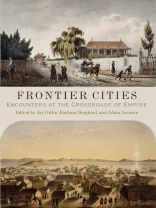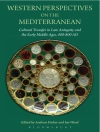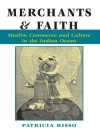Macau, New Orleans, St. Louis, Pittsburgh, and San Francisco. All of these metropolitan centers were once frontier cities, urban areas irrevocably shaped by cross-cultural borderland beginnings. Spanning a wide range of periods and locations, and including stories of eighteenth-century Detroit, nineteenth-century Seattle, and twentieth-century Los Angeles, Frontier Cities recovers the history of these urban places and shows how, from the start, natives and newcomers alike shared streets, buildings, and interwoven lives. Not only do frontier cities embody the earliest matrix of the American urban experience; they also testify to the intersections of colonial, urban, western, and global history.
The twelve essays in this collection paint compelling portraits of frontier cities and their inhabitants: the French traders who bypassed imperial regulations by throwing casks of brandy over the wall to Indian customers in eighteenth-century Montreal; Isaac Friedlander, San Francisco’s ‘Grain King’; and Adrien de Pauger, who designed the Vieux Carré in New Orleans. Exploring the economic and political networks, imperial ambitions, and personal intimacies of frontier city development, this collection demonstrates that these cities followed no mythic line of settlement, nor did they move lockstep through a certain pace or pattern of evolution. An introduction puts the collection in historical context, and the epilogue ponders the future of frontier cities in the midst of contemporary globalization. With innovative concepts and a rich selection of maps and images, Frontier Cities imparts a crucial untold chapter in the construction of urban history and place.
สารบัญ
Introduction: Local Crossroads, Global Networks, and Frontier Cities Jay Gitlin, Barbara
—Berglund, and Adam Arenson
I. PRECEDENTS: IMPERIAL PLANS AND COMMERCIAL VENTURES
Chapter 1. The European Frontier City in Early Modern Asia: Goa, Macau, and Manila
—Alan Gallay
Chapter 2. Colonial Projects and Frontier Practices: The First Century of New Orleans History
—Daniel H. Usner, Jr.
II. URBAN SPACE AND FRONTIER REALITIES IN THE EIGHTEENTH CENTURY
Chapter 3. Insinuating Empire: Indians, Smugglers, and the Imperial Geography of Eighteenth-Century Montreal
—Brett Rushforth
Chapter 4. On the Edge of the West: The Roots and Routes of Detroit’s Urban Eighteenth Century
—Karen Marrero
Chapter 5. People of the Pen, People of the Sword: Pittsburgh in 1774
—Carolyn Gilman
III. NETWORKS AND FLOWS: THE FRONTIER CITY IN THE NINETEENTH AND TWENTIETH CENTURIES
Chapter 6. Grain Kings, Rubber Dreams, and Stock Exchanges: How Transportation and Communication Changed Frontier Cities
—Elliott West
Chapter 7. Frontier Ghosts Along the Urban Pacific Slope
—Matthew Klingle
IV. RENDERINGS: VISUALIZING AND READING THE FRONTIER CITY
Chapter 8. Locating the Frontier City in Time and Space: Documenting a Passing Phenomenon
—Timothy R. Mahoney
Chapter 9. Mapping the Urban Frontier and Losing Frontier Cities
—Peter J. Kastor
Chapter 10. Private Libraries and Global Worlds: Books and Print Culture in Colonial St. Louis
—John Hoover
Epilogue. Frontier Cities and the Return of Globalization
—Jay Gitlin, Barbara Berglund, and Adam Arenson
Notes
List of Contributors
Index
Acknowledgments
เกี่ยวกับผู้แต่ง
Jay Gitlin is Associate Director of the Howard R. Lamar Center for the Study of Frontiers and Borders at Yale University. Barbara Berglund is Associate Professor of History at the University of South Florida. Adam Arenson is Assistant Professor of History at the University of Texas at El Paso.












